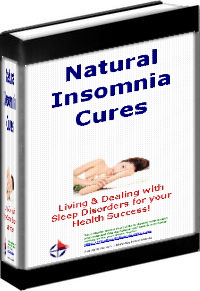|
What are child sleep disorders?
Here we cover the most common sleep disorders that children will experience, and some sensible and natural home remedy sleep aids to help you all to sleep better every night. Problems with sleep behaviors are commonly seen in children. Sleep is of primary importance at all stages of human development, and in the newborn, is the primary activity other than eating. Childhood sleep disturbances affect not only the child but also the whole family. There is an abundance of different beliefs and lore on this topic. Sifting through the enormous amount of material, approaches, and opinions about kids' sleep can be daunting for parents. There is not one correct way to deal with your child in regard to sleep. Each child is unique and has his own special set of circumstances and needs. What's important is for parents to identify what they feel comfortable with and what they feel is best for their child. Just as parents pay attention to their children's general hygiene, they can also address their sleep hygiene. This can be made a pleasurable event. 
This can help to establish life-long patterns of good sleep. It's much easier to prevent a sleep problem than to treat one. The important daily sleep requirements in sleep hygiene is consistency. Bedtime should occur at the same time each night. A regular habit of storytelling, reading a book, or talking about the day's events are often nightly rituals that parents can implement. This can be a meaningful period of engagement for both the parent and the child. Typical bedtime sequences take around 30 minutes. Often children engage in what has been referred to as "curtain call" behaviors. These are behaviors by the child that delay separation from the parents before bedtime. Kids will often get up and say they need to go to the bathroom, or that they need to get a glass of water. Sometimes these behaviors become problematic. I recommend children be asked to do these things for themselves. This avoids reinforcing these behaviors by granting more contact with the parents.
Common Child Sleep Disorders:
Different sleep difficulties tend to cluster around different ages. Before the age of three it is common for infants to have problems going to sleep and nighttime awakening. Nightmares, fear of the dark, and night terrors usually begin to occur between ages 3-6, and sleepwalking usually has its onset after age 6. Sleep problems appearing later and in adolescence are more frequently associated with underlying psychiatric disorders, drug abuse, or medical conditions like narcolepsy. At what stage should kids sleep in their own beds? There are different philosophies about children sleeping in the same bed as their parents. Western culture expects children to sleep alone from a very early age. In non-Western cultures, families tend to sleep together for a much longer period of time. Parents generally have to decide what works for them and their lifestyle. This issue can sometimes be a source of conflict between parents. The older a baby is when he is sleeping with his parents, the more difficulty they are likely to experience when making the transition from their bed to the child's own bed. Kids generally love to sleep with their parents. Once used to this they can be quite resistant to changing. It's important for parents to be aware of the impact that this has on their own time for both sexual and emotional intimacy.
Night Wakings
Infants sleeping alone often wake at night and fall back asleep without the parents being aware of the arousal. Some infants, as most parents know, cry upon awakening and this can become a regular and frequent habit. The concerned parent may rush in to see that the child is okay and to provide comfort. If a healthy baby continuously awakens this can be a source of distress for the parents. One popular intervention is "Ferberizing." This is a method popularized by Dr. Richard Ferber. Basically it involves letting the child continue to cry for increasingly longer periods of time without intervening. The goal is to foster the child's ability to "self-sooth" or put themselves back to sleep. This is effective after a few days for many children. However, some parents don't feel comfortable with what they perceive as a "cold turkey" approach. Parents need to do what they feel comfortable with and often do well with modified approaches. I advise parents to try and not respond instantaneously to the child's awakening and crying. An instant response is likely to be gratifying to the child and increase the likelihood that this behavior will recur. Frequently a baby will cry for 20-30 minutes and then fall back asleep. A timer is often useful to keep track of how long your child has been crying (20 minutes at 2 am can seem like 2 hours). Children often respond rather quickly to methods like "Ferberizing." However, transitions, changes in environment, travel, and illnesses can causes these difficulties to recur.
Night Terrors versus Nightmares
Night terrors start to occur in the 3-5 age range, as well. Night terrors are distinct from nightmares. With night terrors, children will begin to scream and cry in the middle of the night but still be asleep. These episodes are self-limited and it is best to hold the child, not attempt to awaken them, but comfort them until they have settled down again. Night terrors tend to run in families and usually resolve spontaneously. At times the problem will be frequent and severe enough that medication is used. Nightmares are frightening dreams that occur during REM sleep and awaken a child. They usually occur in the later part of the night. Most children have at least one nightmare during childhood; three percent of preschool and school aged children experience frequent nightmares, according to NSF’s 2004 Sleep in America poll. They can be upsetting and a child will need reassurance when they occur. Nightmares can result from a scary event, stress, a difficult time or change in a child’s routine. Use of a nightlight or security object is often helpful. Sleep terrors occur early in the night. A child may scream out and be distressed, although s/he is not awake or aware during a sleep terror. Sleep terrors may be caused by not getting enough sleep, an irregular sleep schedule, stress, or sleeping in a new environment. Increasing sleep time will help reduce the likelihood of a sleep terror.
Insomnia is a sleep problem that occurs when a child complains of difficulty falling asleep, remaining asleep, and/or early morning awakenings. Insomnia can be short-term due to stress, pain, or a medical or psychiatric condition. 
It can become long-term if the underlying cause is not addressed or healthy sleep practices are not employed. Treating underlying conditions, developing good sleep practices and maintaining a consistent sleep schedule can improve the ability to fall asleep and stay asleep.
Restless Legs Syndrome (RLS) is a movement disorder that includes uncomfortable and unpleasant feelings (e.g. crawly tingly or itchy) in the legs causing an overwhelming urge to move. These feelings make it difficult to fall asleep. RLS can be treated with changes in bedtime routines, increased iron, and possibly medications.
Snoring occurs when there is a partial blockage in the airway that causes a noise due to the vibration of the back of the throat. About l0-12 percent of normal children habitually snore. Snoring can be caused by nasal congestion or enlarged adenoids or tonsils that block the airway. Some children who snore may have sleep apnea.
Sleep apnea – when snoring is loud and the child is having difficulty breathing, it may be a sign of a more serious disorder, obstructive sleep apnea. Sleep apnea is characterized by pauses in breathing during sleep caused by blocked airway passages, resulting in repeated arousals from sleep. Sleep apnea has been associated with daytime sleepiness, academic problems, and hyperactivity. Treatment for sleep apnea is available.
Sleeptalking occurs when the child talks, laughs or cries out in his/her sleep. As with sleep terrors, the child is unaware and has no memory of the incident the next day. There is usually no need to treat sleeptalking.
Sleepwalking is experienced by as many as 40 percent of children, usually between ages three and seven. Sleepwalking usually occur an hour or two after sleep onset and may last five to 20 minutes. As sleep deprivation often contributes to sleepwalking, moving bedtime earlier can be helpful. Sleepwalking, like night terrors, tends to run in families. This problem emerges more frequently sometime after age 6. A child can get up and walk around while still in a sleep state. At times, the child can open doors and go outside. When the problem is this severe and can possibly endanger the child, medication is used. Generally the child should be led back to bed without attempting to awaken him. Sleepwalking tends to spontaneously resolve. Click on the link to learn more about specific sleep disorders in-depth, and their natural home remedies as well as treatments that may be required.
Pointers for parents: Talk to your child’s doctor if any of the following symptoms are observed: • A child is having problems breathing or breathing is noisy.
If you regularly have to wake your child in the morning, it could be a sign that he or she isn’t getting enough sleep. The number of hours a toddler sleeps will be different for each child. However, most toddlers are consistent in how much they sleep from one day to the next.
Build a regular bedtime routine everyone enjoys. For a toddler, this could include: Your toddler’s sleep patterns will continue to change. Toddlers can generally sleep through the night, although change and stressful events (a trip or illness, for example) can cause temporary setbacks. All children wake briefly at regular intervals throughout the night. A toddler who’s learned to fall asleep on his or her own will be able to return to sleep in the middle of the night without help from you—although normal bedtime fears and nightmares may need your reassurance. Set a regular sleep schedule. Establish regular naptimes and a bedtime that allow your toddler to get all the sleep he or she needs. Restricting naps won’t help a toddler sleep better at night. Quite the opposite—it can lead to overtiredness and more sleep problems. But avoid naps late in the afternoon. Many babies become fussy or cry when they get tired, but others will rub their eyes, pull on their ears, or even stare off into space. Put your baby down for bedtime or a nap when your baby first lets you know he or she is tired. Wind down your routine where your child sleeps. Make sure the last few soothing minutes of the bedtime routine happen right in your toddler’s room. Give your toddler soothing surroundings. 
Keep the bedroom dark, cool and quiet. A night-light is fine. A television isn’t. And make sure the environment is the same at bedtime—lighting, for example—as it will be throughout the night. Put your child to bed drowsy but awake. This may teach your toddler to fall asleep, as well as to go back to sleep in the night on his or her own, with little if any help from you. Whatever routine you have established at bedtime will need to occur again if your child wakes in the middle of the night. So create a routine that helps your child fall asleep on his or her own. Set limits. If your child stalls at bedtime, set clear limits, such as how many books you will read or how many drinks of water you will allow. Make sleep a family priority. Remember, looking after a toddler takes plenty of energy. You need your sleep, too.
Sleep Tips for Toddlers: • Maintain a daily sleep schedule and consistent bedtime routine.
Diet change strategies: So that old-fashioned glass of warm milk or cocoa before bed seems to have a foundation in fact! Vitamin & Nutrient Associations ‘Studies have shown a link between Vitamin B12 and other health conditions including insomnia. The body requires vitamin B12 to manufacture red blood cells and myelin. Myelin is the fatty lining around nerve cells. There has been a great deal of research into the effectiveness of vitamin B12 injections and multiple sclerosis. You may find benefit from our information on detoxification As well as about detoxing because of change of diet It may be due to difficulties with your digestive system that is causing your body to be starved of key nutrients, vitamins or minerals. In this case you may find useful answers by reviewing our article on Nutrition For Your Cells. There is also more information here about why is nutrition such an issue nowadays? It may be that your metabolism has slowed due to pressures that have been placed on your system through life in general or through specific “challenges” you have faced in the last few months or last few years. Review this by looking at our article about balancing your Metabolic Rate. We wish you well in your search for solutions to this problem and your movement towards better health in all areas.
More Resources available about child sleep disorders :
sleep disorders
daily sleep requirements When we sleep well, we wake up feeling refreshed, alert and ready to face daily challenges. When we don’t meet our daily sleep requirements, every part of our lives can suffer. Our jobs, relationships, productivity, health and safety (and that of those around us) are all put at risk.
Energy Quiz Restless Leg Syndrome
Natural Sleep Aids & better sleep Tips Jet lag sleep disorder snoring Generally, snoring is most common in men than women. Overweight people show more tendencies to snore than those within normal weight. Age appears to aggravate the situation as well. sleep apnea
We also feature new health articles & self care solutions every month in “Your Health Success” our FREE Health Magazine, so subscribe today to stay up-to-date!
 to “Your Health Success” our monthly F’R’E’E’ Newsletter
Back to Top of your health online child sleep disorders page *** GENERAL RELEASE AND ASSIGNMENT I understand that in submitting my material for publication I am granting the rights to reproduce this material on the internet or in other form and I have read the conditions above
============================================================
|


